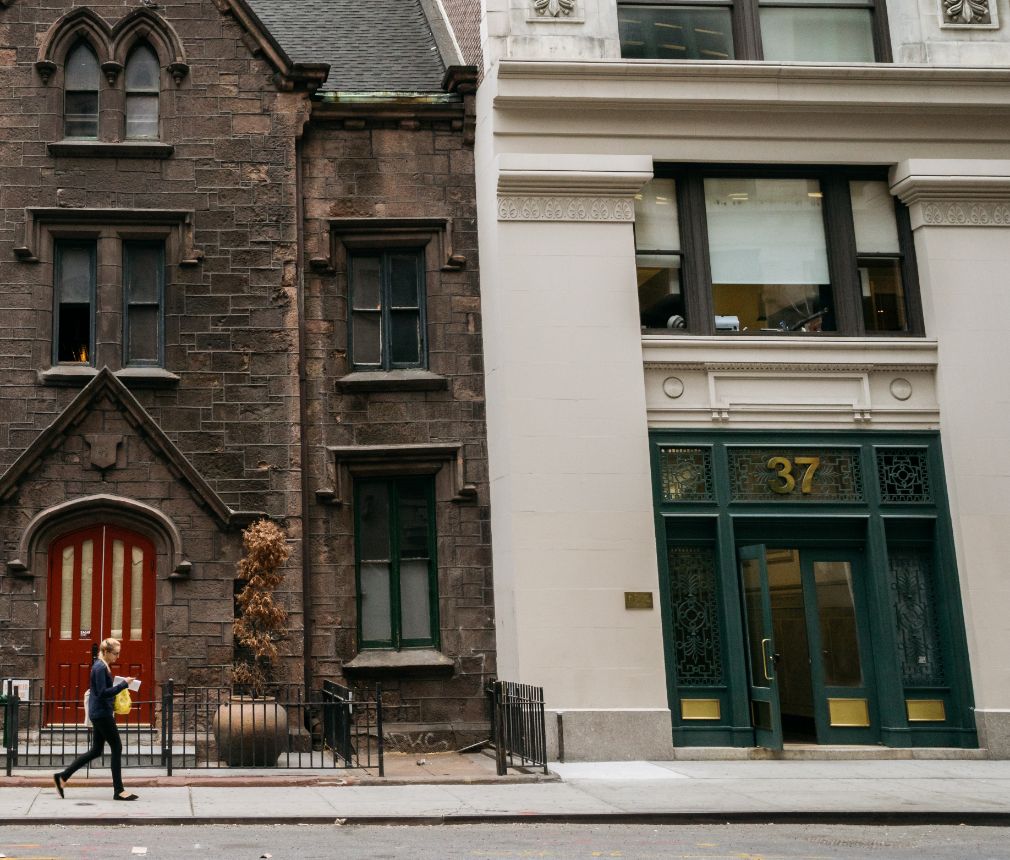Bunions Treatment
in New York, NY
Bunions
Bunions refer to a misalignment of the first metatarsal-phalangeal or first MTP joint located at the base of the big toe. This bony lump can present both physical pain and aesthetic discomfort, so addressing it is paramount for many bunion sufferers.
Bunions

What Causes Bunions?
This common disorder affects more women than men and can be caused by:
- Tight or narrow shoes (especially high heels)
- The shape of your foot (genetics)
- Flattening of the foot
- A medical condition, such as arthritis
Chelsea Foot and Ankle in New York City provides effective surgical and non-surgical options to treat bunions and restore full foot function.
How Do I Know if I Have Bunions?
An in-depth consultation with Dr. Ethan Ciment or Dr. Michael Collins is your first step to a precise diagnosis.
Our doctor(s) will examine your feet and ankles to determine the probable cause of your pain or functional complaint.
They will listen carefully to your concerns and symptoms and then create a treatment plan, including the appropriate diagnostic imaging and procedure(s) for your specific condition.
Some typical bunion symptoms include the following::
- A bump or bulge forming at the side of the base of your big toe
- Pain, tenderness, redness, swelling around the joint of your big toe
- Corns or calluses where the big toe rubs against the second toe
- Reduced ability to move your big toe
Why Choose Chelsea Foot and Ankle To Treat Your Bunions?
At Chelsea Foot and Ankle, we understand how debilitating it can be to live with foot pain. That’s why we strive to provide quick and effective treatment and get you back to feeling like yourself.
Our team considers every patient as part of the family and will treat you like the VIP you are. We respect you and your time and offer comprehensive services at reasonable prices customized to meet your unique needs.
What Are Your Non-Surgical Bunion Treatment Options?
As a bunion develops, the big toe can drift toward the second toe or under it. The skin on the bottom of the foot may also become thicker and more painful.
If allowed to progress, the pressure from the big toe may force your second toe out of alignment and cause it to overlap your third toe. Debilitating arthritis can result from an untreated bunion.
At Chelsea Foot and Ankle, we start with a conservative approach whenever possible. This may consist of protective pads to cushion the joint while you wear more comfortable shoes.
Custom orthotics can be made at Chelsea Foot and Ankle to correct the over-flattening of the foot that often triggers bunions and help realign the front of the foot so that the big toe and first MTP joint can function correctly.
Our doctors have successfully treated bunions in mild to moderate cases without invasive surgery.
What if You Need Bunion Surgery?
Like shoes, one bunion does not fit all. There are different types of bunions, and dozens of surgical approaches are used to address them.
Choosing the correct technique for each bunion is critical in getting the ideal outcome.
Regardless of which surgical procedure is chosen, a “bunionectomy” is performed to realign the first MTP joint with the bones, ligaments, and tendons of your big toe so they can be brought back to their correct position to restore proper pain-free function.
Bunion surgeries are performed on an outpatient basis, using sedation and local anesthesia, with no hospital stay needed.
What Is Recovery From Bunion Surgery Like?
Recovery time will vary from patient to patient but can take a month or longer. Most individuals need to wear special footwear, like a boot or splint, early in recovery to protect the foot and allow it to heal.
There is minimal downtime, and crutches are rarely needed, with most patients walking out of surgery. For those who work on their feet, taking 7 to 10 days is usually sufficient before returning to a modified standing work schedule.
After stitches are removed, our doctors routinely recommend physical therapy to strengthen the foot and restore normal range of motion and function to the foot.
The Chelsea Foot and Ankle doctors take your recovery seriously and follow your progress closely during this time.
You will be scheduled for weekly visits for our team to assess every aspect of your healing process, and any further recommendations will be made to ensure the best possible outcome.
How Can You Prevent Bunions?
Bunions develop over time, and caring for your feet during childhood and early adulthood is essential. Monitor the shape of your feet over time, especially if foot problems run in your family.
Some tips include:
- Wear shoes that fit properly
- Avoid shoes with high heels or a pointed toe
- Exercise your feet
- Practice picking up small objects with your toes
If you have a bunion and you have yet to check it out, now is the best time to do it. The sooner it’s evaluated, the sooner an intervention can be initiated, and the more likely you will not require surgery to fix your bunion.
Bunion Surgery FAQ
How can I prepare for bunion surgery?
Bunion surgery will generally alleviate your symptoms successfully, but it is still an invasive procedure that you must prepare for. At Chelsea Foot and Ankle, our team makes every effort to inform our patients so they know exactly what to expect. To make the process easier, you can prepare for bunion surgery by:
- Go over the pre-and post-operative instructions we will provide you so you know exactly what to expect. Be sure to write down any questions you have and call our office before surgery so we can help you out in any way.
- Prepare your medications and other surgical supplies. The sooner you do this, the easier your recovery will be. You may be advised to take over-the-counter or prescription pain medications after your procedure, so be sure to fill prescriptions ahead of time. Stocking up on ice packs and other comforting recovery supplies may also be helpful.
- Following surgery, you may be housebound for a few days. Set up your space beforehand to recover when you get home from surgery. You may want to have ready a space with an armchair or ottoman to keep your feet elevated.
- Stock up on other necessities. It might be challenging to get around in early recovery, so prepare meals that are easy to heat up and get some grocery shopping done that will last you long enough to recover in peace.
- Let your friends and family know you’re about to have surgery. They may be able to help you around the house for the first few days and check in on you as you recover.
What happens on the day of surgery?
Bunion surgery generally happens on an outpatient basis so you can return home after your procedure. Be sure to wear comfortable clothing that is easy to put on and remove. Before surgery:
- You will be asked to put on a gown
- An IV line will be started in your arm or hand
- The skin over the foot and ankle with the bunion will be cleansed
- The patient will be fully sedated
- Your surgeon will perform the operation
- They will close the skin with stitches and apply a dressing or bandage
- Once you have recovered from the anesthesia, you will be examined and discharged with a post-op shoe/boot and a cane to use for balance when walking.
- You will be given specific aftercare and recovery instructions
How can I make bunion surgery recovery easier?
Recovery from bunion surgery varies from patient to patient, depending on the extent of concerns, the surgical plan, and the patient’s natural healing process. To make the recovery process more manageable, strictly follow your post-operative instructions. As you recover, do not push yourself. Be sure to elevate your foot as much as possible. The better you care for your healing foot during recovery, the easier the healing process.
To ensure a speedy recovery, eat healthy, whole foods rich in nutrients and drink lots of water. This will help your body heal faster and make the process easier. Additionally, moving your body a little each day is a good idea. This increases circulation, which aids in healing and reduces the chance of blood clots.
If you ever have any questions during your recovery, such as what to do and not do, don’t hesitate to call us.
If you need relief from bunion pain, call our office today at (646) 929-4149! Don’t forget to check out our blog to learn more about us!
We always put our best foot forward…so you can too!
Your New York City Podiatrist for Bunion Treatment
Whether you want to prevent a bunion from progressing early with conservative treatment or you have severe bunions that may need surgery, you can trust the doctors at Chelsea Foot and Ankle.

Are you interested In healing your bunion?
If you need relief from bunion pain, call our office today at (646) 929-4149! Remember to check out our blog, where you can learn more about us!
Our Patients Love Us
I have been very impressed with Dr. Ciment, unlike most Drs he doesn’t seem in a rush to diagnose you and takes the time to hear about your injury and past injuries. He genuinely seems to care about finding the right path to recovery. Michael is also very friendly and helpful to work with. Highly recommend!
Dr. Ciment is absolutely amazing! He is very welcoming and does an incredible job assessing and explaining his prognosis. My physical therapist was also impressed with his communication to her.
